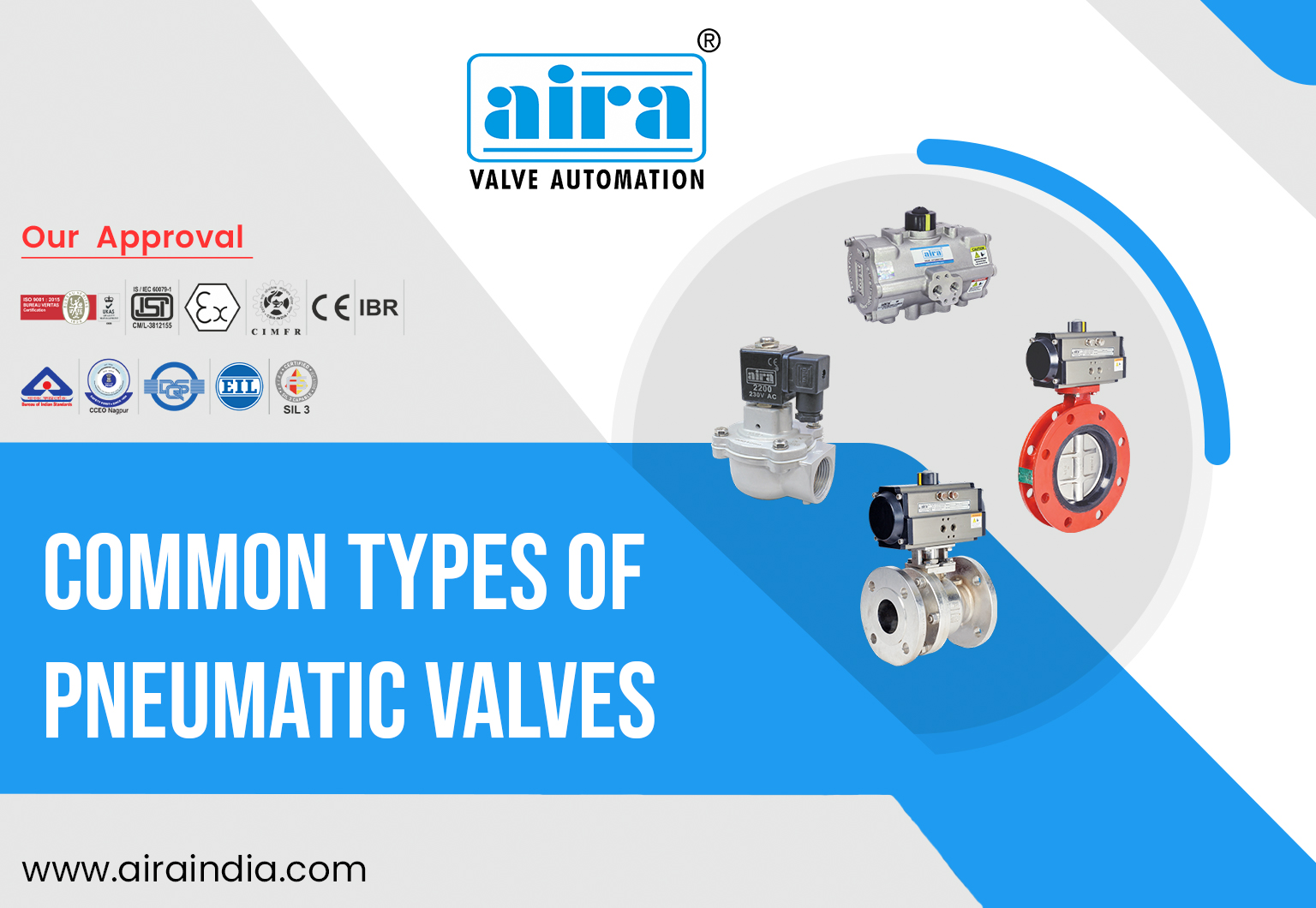A pneumatic valve, often known as a directional control valve, has one major function: to alter airflow. These valves can keep the pressure consistent. There are various pneumatic valve classifications and a diverse range of pneumatic valves. Pneumatic valves are classified based on style, design principle, operation type, function, size, and application.
The pneumatic valve is capable of switching on and off a single flow route as well as exact proportional pressure and flow control. Most pneumatic valves include a control function, which may be described as the valve’s operation in any process or quality control. A control function requires control energy, which is defined by the manner of actuation (manual, mechanical, hydraulic, or pneumatic).
Aira Euro Automation is India’s top valve manufacturer. We are well-known for offering the best quality pneumatic valves in the industrial market. Our premium Pneumatic Ball Valves, Pneumatic Butterfly Valves, Pneumatic Control Valves, and Solenoid Valves are the leading choices in the industrial market.
What is the Operation of a Pneumatic Control Valve:
Pneumatic control valves use actuators and positioners controlled by a controller to lower pressure safely. Controllers can detect pressure changes and alter the air supply signal sent to the pneumatic positioner. A pneumatic positioner would pump air into the diaphragm, allowing a valve to be opened. Springs are used as an opposing force, causing the valve to close when air pressure applied to the diaphragm is lost or reduced. Many industries rely on pneumatic control valves.
Types of Pneumatic Valves
At Aira Euro Automation, we produce a comprehensive range of Pneumatic Valves to meet the needs and support the expansion of your business and industry.
Pneumatic Ball Valve
Aira offers a wide range of Pneumatic Ball Valves, which control the flow if liquid or gas through a rotating ball with a bore. Pneumatic Actuators convert compressed air energy into mechanical motion, controlling the rotating ball. These valves consist of two main components: the pneumatic actuator and ball valve, which are typically mounted together by API 6D & ISO 17292 for ANSI Class ratings 150 to 600, with Nominal Size available from “½ to 12” inches.
Pneumatic actuators can be single or double-acting, with single-acting actuators using compressed air to rotate the ball and a spring to move it back to its normal position, and double-acting actuators Using pressurized air, move the ball in any direction.
“Air-actuated ball valves are a reliable solution and often have a lower investment cost for larger valves than electric ones.”
There are various housings and sizes of pneumatic ball valves, making it easy to find the right one for your application. Air-operated ball valves are commonly used to remotely control fluid flow, such as water pipes or air hoses.
Pneumatic Butterfly Valve
These valves come with either a lug or a wafer connection design. Depending on the actuator type (single or double-acting), the actuator will open and close the butterfly valve with compressed air. The butterfly valve contains a disk that revolves with the actuator to open and close it.
The butterfly valve design provides excellent sealing qualities, longevity, and dependability for your application. Pneumatic actuators are a dependable option that is frequently utilized to operate bigger valves than electric actuators at a cheaper initial cost. Pneumatically controlled butterfly valves come in a variety of housings, seals, and sizes, making it easy to pick the correct one for your application.
Pneumatic Solenoid Valves:
Pneumatically operated A solenoid valve is an industrial valve that operates using pneumatic force. When air pressure is applied to the solenoid coil, a magnetic field is formed, causing a ferrous metal rod to move. This is the fundamental mechanism that opens the valve, and it acts either directly or indirectly on air.
Normally open (N/O), the valve remains open when the solenoid is not charged. The valve is normally closed (N/C) when the solenoid is not charged. Solenoid valves eliminate the need for human or pneumatic control of a pneumatic circuit, requiring just an electrical input (and air pressure for piloted valves) to function, making them simple to configure and install in a broad range of applications.
Advantages of Pneumatic Valves
Pneumatic Systems are designed to transmit and control energy using compressed air. Pneumatic systems are found in manufacturing lines, tran doors, and mechanical clamps. Many industrial companies would only be able to function with the specialized use of pneumatic control systems. Pneumatics is often the driving force behind automated machines. Among the advantages of using these devices are:
Compressed air systems never run out of air because an infinite amount of air in our atmosphere can be used to provide compressed air. Compressed air is easily delivered through pipes and is not restricted by distance. When compressed air is released back into the atmosphere, it does not require recycling or processing. The instruments are long-lasting and dependable. When compared to other electromotive elements, these machine’s components, such as pneumatic valves, are not easily damaged.
Pneumatic systems are typically believed to be safer than electrometer systems. This is because pneumatic systems do not emit sparks or explosions, implying that they may be used in flammable situations.
Unlike electromotive components, pneumatic systems do not overheat or burn when overloaded.
Conclusion
In conclusion, pneumatic valves are important additives in numerous industrial packages, imparting specific manipulation over airflow and stress. The not unusual kinds, together with directional manipulate valves, glide manage valves, stress remedy valves, and test valves, every serves specific functions to ensure the green operation of pneumatic structures.
Understanding the awesome functions and packages of every type permits for better device design and maintenance, leading to superior overall performance and reliability. As technology advances, the development of greater sophisticated pneumatic valves keeps, promising even more efficiency and capability in automated tactics. Trust Aira Euro Automation, we are the leading Valve manufacturer in Ahmedabad, India.
